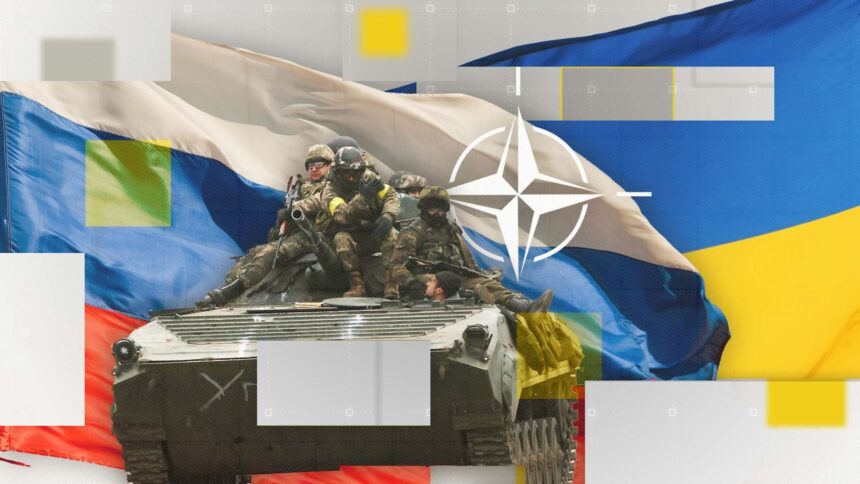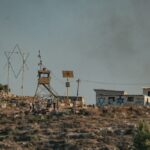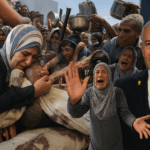Summary by Geopolist | Istanbul Center for Geopolitics:
The article challenges the idea that Russia’s actions in the war with Ukraine are solely a response to NATO expansion. Instead, it argues that Russia’s aggression is driven by imperialist ambitions and a desire to eliminate Ukraine as an independent nation.
Dr. Michael Lawriwsky, the author of the article, highlights the destruction of Ukrainian culture and the mass atrocities committed by Russia. He emphasizes that these actions align with Russia’s historical efforts to dominate Ukraine.
Read more below.
The Russian-Ukrainian War: “NATO-Fault” Thesis Proponents Can’t Explain Why it’s Genocidal
The view that Russian aggression towards Ukraine is driven solely by the goal of maintaining its neutrality as a buffer state must ignore certain realities. Its most important omission is that Russia’s military actions and the genocidal tactics employed against Ukrainians align with a broader historical narrative of reasserting dominance over regions seen as integral to Russian identity.
In a recent article in Australian Outlook, Tom Switzer, the executive director of the Centre for Independent Studies (CIS), asserted that Russia’s “strategic objective” in the Russian-Ukrainian War “is to annex some Ukrainian territory and badly weaken the country so it cannot join NATO.”
No evidence was provided for the hypothesis that a “badly weakened Ukraine” could not join NATO. Even if Ukraine were ground to an exhaustive stalemate and agreed to territorial concessions that kept it divided, it would still by definition (i.e. the fact that Russia had not overrun it) have a stronger military than many current NATO members. All that would be required for Ukraine’s NATO membership is the political will of other NATO states. Furthermore, West Germany was “weak and divided” in 1955 when it was accepted into NATO—because it was a strategic imperative. It didn’t lead to nuclear war, but instead acted as an effective deterrent on the USSR. Had Ukraine been a member of NATO in 2014, Russia would likely not have invaded either. The only reason that Russia feared NATO expansion was that it would have denied Russia the option to invade Ukraine.
What Tom Switzer and others holding the view that the current war is “NATO’s fault” do not appear to understand is that Russia was never going to be satisfied with just Ukrainian “neutrality.” Putin always sought Ukraine’s complete subjugation and ultimate incorporation into the Russian state. A Russian war on Ukraine was being waged since the 1990s using soft power techniques, including corrupt gas contracts, promotion of traitorous oligarchs like Viktor Medvedchuk and his TV stations, support for the FSB-laden Russian Orthodox Church in Ukraine, and the infiltration of Ukrainian institutions and security apparatus by Russian agents.
With two and a half years of hindsight, Switzer’s idea that “Russian armed forces lack the military power to conquer Ukraine” cannot support his position that this war was never about imperial conquest. That view is undermined by the fact that Russian TV expected Ukraine to fall in 72 hours, as did the White House, top US generals, German ministers, and the invading Russian forces who brought their dress uniforms with them. That Vladimir Putin’s anger over the bungled invasion was unleashed in an extensive purge of military and security services leaders in March 2022 suggests he held the same view.
Russia’s apparent indifference to Sweden’s and Finland’s accession into NATO, which materially increases the NATO border with Russia and places Saint Petersburg much closer to NATO, testifies that “NATO expansion” was never the real issue. Russia’s leaders never believed NATO would invade their sovereign territory and that was the correct view (even though Ukraine outside of NATO has now been forced to). When Sweden and Finland joined NATO in what some observers considered an “escalatory move,” Russia responded by shifting military units away from the Finnish border to its invasion forces in occupied Ukraine. That’s how concerned Russia’s leadership is about “NATO encirclement.”
A keystone claim of the “NATO expansion” argument is that the West made an implicit promise to Moscow not to move “one inch eastwards.” However, it is not clear that such a promise was ever made, and the notion of “Western betrayal” was scoffed at by Mikhail Gorbachev himself in a 2014 interview with German public TV broadcaster ZDF. He described it as a “myth … because the question did not even arise back then.” Furthermore, the swathe of central-eastern European countries that joined NATO in the late 1990s (like Poland, Hungary, and Czechia) were not being gobbled by up an “expansionist NATO,” but rather were securing themselves against a revanchist Russia. Unlike most in the West, and especially Tom Switzer’s “wise men who warned against NATO expansion” who were drunk on the euphoria of the USSR’s collapse, these countries had centuries of bitter experience with Russia and took note of what they saw.
While the pages of Foreign Affairs were filled with optimistic forecasts of what could now be, that journal largely turned a blind eye to what revanchist Russia was already doing in the early 1990s. Since 1992 the 14th Russian Army occupied the north-eastern rim of Moldova, known as Transnistria, and has remained there to this day. In July of 1992 Estonian troops exchanged shots with Russian soldiers over the continued presence of Russian troops, and Russia was demanding US$7.7 billion in compensation from the Baltic States to secure the withdrawal of its troops. There were continued arguments between Russia and Ukraine over the split of the Black Sea Fleet, and Russia was meddling in Abkhazia, South Ossetia, and Nagorno Karabakh.
Tom Switzer’s list of “wise men” includes “Cold War Warriors” like Owen Harries and Robert McNamara, but there were other voices he ignored. In a 1997 Foreign Affairs article Zbigniew Brzezinski also urged “benign American hegemony” and a cautious and generous approach to assist Russia’s “assimilation into a larger framework of European cooperation.” But this was contingent upon also “fostering the independence of its newly sovereign neighbors.” In contrast to Switzer’s “wise men,” he foresaw that between 2005 and 2010 Ukraine could begin NATO and EU accession talks “provided it has made significant domestic reforms.” In his view the real danger was that “[f]ailure to widen NATO, now that the commitment has been made, would shatter the concept of expanding Europe and demoralize the Central Europeans. Worse, it could reignite dormant Russian political aspirations in Central Europe.” It was Brzezinski who got it right and not Tom Switzer’s “wise men,” because this war would not have happened if NATO had expanded to include Ukraine.
By the early 2000s a number of other neighbours of Russia had witnessed further unsettling developments. The First Chechen War led to a treaty between Chechnya and an exhausted Russia being signed in 1997, only to be abrogated by Putin in 1999 with the launching of the Second Chechen War, which saw the complete levelling of Grozny. In 2003 Russia began laying claim to Ukraine’s Tuzla Island in the Kerch Strait. Ukraine’s president Leonid Kuchma had to deploy troops, artillery boats, and Grad missile systems before Putin backed down. This was just after Ukraine had sent peacekeeping forces to Iraq and Afghanistan.
In 2004 Bulgaria, Estonia, Latvia, Lithuania, Romania, Slovakia, and Slovenia were eager to join NATO. Those countries were running from what they saw coming. They didn’t see it all though. Andrei Illarionov, who in more recent years has resided at the CATO Institute, was Putin’s chief economic adviser between 2000 and 2005, and through his regular contact with Putin saw much more. In a recent interview with the Kyiv Post Illarionov noted that Putin’s plan to invade Ukraine was laid out in a 17 September 2003 meeting with his top level ministers where he told them it was intolerable for Kyiv, under his false narrative that it was “the cradle of Russian civilisation,” to reside outside of the Russian state. This pivotal meeting pre-dated the 2004 round of NATO accessions. In light of what he knew, on 3 February 2014, three weeks before President Viktor Yanukovych fled to Russia, Illarionov predicted that Russia would invade Ukraine. None of Switzer’s “wise men” were anywhere near Putin to know him—and Russia generally—in the way that Illarionov does.
If Switzer’s often-repeated view that Russia’s “strategic objective” was to merely maintain Ukraine’s “neutrality” as a “buffer state,” there would not be any need to wipe Ukraine and Ukrainians from the face of the map. The University of Chicago’s Professor John J. Mearsheimer and CIS’s Tom Switzer will never use the term “genocide” to describe what has been happening in Russian-occupied Ukrainian territory, while genocide and Holocaust scholars like professors Eugene Finkel and Timothy Snyder do. Proponents of the NATO-fault thesis will never mention the banning of the Ukrainian language, the destruction of Ukrainian books, libraries, publishing houses, museums and culture, mass executions, kidnapping of tens of thousands of children, relocations of Ukrainians to re-education camps, and the influx of Russian colonial settlers to devastated cities like Mariupol.
A Russian imperialist / historical mythology hypothesis, by contrast, is fully consistent with Russian behaviour, as the elimination of Ukrainians as a people would allow Moscow to reassert its historical myth that “Russia was founded in Kyiv.” Furthermore, Russia’s genocidal intentions are not hidden—they are voiced every day on Russian TV, and ignored by Western mainstream media. Putin doesn’t hide it either. His 2021 “historical essay” denied the existence of Ukrainians as a people, and the first half hour of his bizarre interview with Tucker Carlson saw Putin launch into a historical diatribe on how “Ukrainians don’t exist” before the interviewer could even say “N-A-T-O?”
Dr Michael Lawriwsky is an author, former chair of the Ukrainian Studies Foundation at Monash University, former editor for the Australian Ukrainian Review, and a former trustee of Melbourne’s Shrine of Remembrance. His career has included positions in academia, investment banking, and consulting.







